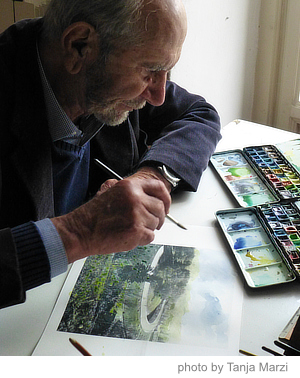 |
 |
 |
 |
 |
 |
| |
 |
|
 |
 |
 |
  |
  |
 |
 |
 |
 |
|
 |
|
 |
 |
 |
BIOGRAPHICAL NOTES |
 |
|  |
|
 |
 |
 |
| |
 |
 Aimaro Oreglia d’Isola was born in Turin on January 14th, 1928. During the war he moved from Turin to the country house in Bagnolo Piemonte (CN). At 16 he took part in the Resistance with the 105th Garibaldi Brigade. He attended the Faculty of Architecture and graduated with Carlo Mollino. He is National Member of the Accademia delle Scienze di Torino, National Academic of the Accademia di San Luca in Rome and Honorary Member of the Società Ingegneri e Architetti di Torino. He is Emeritus Professor at the Politecnico di Torino, formerly Full Professor of Architectural and Urban Design.
 Since 1950 he has worked with Roberto Gabetti in the Gabetti e Isola studio, constituting one of the most fruitful professional partnerships in the panorama of modern and contemporary architecture. Their works have appeared in the main Italian and international magazines and have started, from the well-known Bottega d'Erasmo, a considered debate on the relationship between tradition and modernity. With the passing of Gabetti (2000), the Isolarchitetti studio opens. Many projects signed since the beginning of the activity are characterized by the attention paid to the themes of the landscape and of the environment at different scales. The experience and sensitivity gained through the years are reflected into the new interventions carried out mostly in contexts of high historical and environmental value, continuing the exploration of a wide range of architectural themes, broadening to the design of large areas with high landscape value, like urban sectors and residential complexes, marinas and nautical districts, production areas, parks and infrastructures, in their relationship with complex ecological systems.
Among the main works of the early years are mentioned: La Borsa dei Valori di Torino, outcome of a competition won after graduation (1953); the Bottega d'Erasmo (1952-1956), the Società Ippica Torinese (1958-1959), the monument to the Resistance of Prarostino (1965-67), almost a stone tower, from the top of which it is see the places of the partisan battles. In the area of Bagnolo Piemonte realizes the Church of Montoso (1963-67), the Town Hall (1975-82), the Tuminera (1978-82), the Cistercian Monastery of Prà d’Mill (1988-2005), all buildings that try to interpret and actualize the characters and technologies of those valleys. At the end of the 1960s, he designs the Unità Residenziale Ovest Olivetti in Ivrea (1968-71), an underground construction covered by a large green lawn that lays over with a large arch, almost a theatre cavea, open towards a wooded hill, which poses the theme of the relationship with nature and with pre-existing buildings in an innovative way; this theme was taken up and expanded in the Competition for the Fiat Management Center in Candiolo (1973) and then in the Lingotto Consultation (1983), in the Courtyard in Alba (1982-87), in the Bicocca first and second-degree competition (1987-88), in the competition for the Italian Pavilion at the Venice Biennale (1988) or even in the Elba Residential Complex (1974-1994). Still focused on the relationship between nature and artifice is the project for the Quinto Palazzo Uffici ENI (1985-92), whose modules are all covered with shrubs and trees that reconnect the top of the building with the surrounding park. Recent works include: the New Museo Egizio of Turin (2007-2015); the Design Center of the Politecnico di Torino in Mirafiori (2006-2011); the Nuovo Polo Informatico of the Università degli Studi di Milano (2013-2018); ITT Research & Development in Barge (2014-2018); the works for the restoration and enhancement of Palazzo Te in Mantova, of the MANN-Museo Archeologico of Naples (2019-2022), of Palazzo San Sebastiano in Mantova, of the Museo delle Civiltà in Rome; the Nuova Accademia delle Belle Arti of Bari; the arrangement of cultural and historical sectors, including the works of P.L. Nervi, along the Po river area (with Rafael Moneo); the transformation of the Ex-Manifattura Tabacchi of Venice into a law-court (with Rafael Moneo). |
|
 |
 |
 |
AWARDS |
 |
|  |
|
 |
 |
 |
|
|
 |
Premio Italiano di Architettura
Premio alla Carriera
MAXXI [Museo Nazionale delle Arti del XXI secolo] | TRIENNALE DI MILANO
“la carriera di Aimaro Oreglia d’Isola ha nutrito il dibattito architettonico intorno ai temi del rapporto tra modernità e tradizione, naturale e artificiale, territorio e paesaggio, per tutta la seconda metà del Novecento, traghettandoli fino ad oggi, dove ci appaiono più che mai attuali. L’originalità dello studio si impone fin dai primi anni di attività, per arrivare ben presto a scatenare un intenso dibattito a livello internazionale sul senso dell’architettura moderna rispetto alla storia e alle culture locali. Unitamente all’intensa attività accademica e al valore del disegno che costituisce a sua volta un ulteriore percorso di ricerca parallelo, il pensiero e la pratica di Aimaro Oreglia d’Isola hanno dato e continuano a dare un contributo decisivo all’architettura, intesa come palinsesto culturale e come paesaggio.” |
|
 |
 |
 |
BUILDINGS |
 |
|
 |
|
 |
 |
 |
|
|
 |
|
|
  Italy [Italia]
Italy [Italia]
» Florence [Firenze] |
|
|
|
|
 |
|
|
  Italy [Italia]
Italy [Italia]
» Turin [Torino] |
|
|
|
|
 |
|
|
  San Marino
San Marino
» San Marino |
|
|
|
|
 |
|
|
  Italy [Italia]
Italy [Italia]
» Gignese |
|
|
|
|
 |
|
|
  Italy [Italia]
Italy [Italia]
» San Donato Milanese |
|
|
|
|
 |
|
|
  Italy [Italia]
Italy [Italia]
» Rio nell'Elba |
|
|
|
|
 |
|
|
  Italy [Italia]
Italy [Italia]
» Quart |
|
|
 |
 |
 |
CREDITS |
 |
|
 |
|
 |
 |
 |
| |
 |
| Text and images courtesy of Triennale Milano |
|
 |
  |
 |
|
|